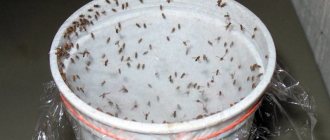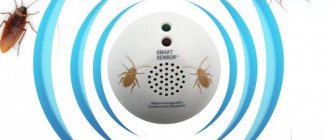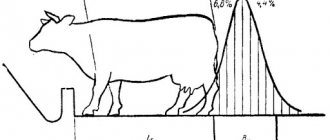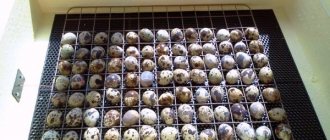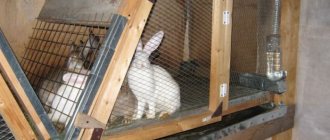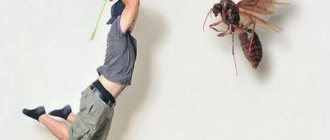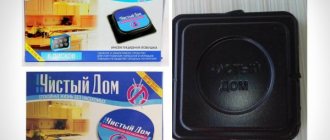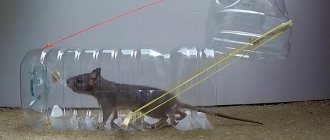The appearance of mice in photographs and cartoons evokes affection. However, when gray tailed creatures penetrate a house, outbuildings, or garages, the attitude towards them changes dramatically. After all, rodents cause not only material damage, which includes damage to food, building materials, and electrical wiring. Mice are carriers of various diseases and helminths, which has serious consequences for human health. Therefore, when rodents are discovered in your possessions, the issue of combating them is beyond doubt. How to make a mousetrap with your own hands and why this method is used most often - the answers to these questions will be useful to novice mouse fighters.
Description of mousetraps
An automatic mouse trap is a device designed to catch mice or other small rodents. In order for the animal to enter the design of such a product, special baits are used. As a result of the rodent's attempt to get food, the position of the lever is disrupted. Then, with the help of specially organized weights, the support or equipped trigger mechanism is overturned. The result is an animal caught in a trap.
An automatic mouse trap is a device designed to catch mice or other small rodents.
Additional Information! Moreover, it is necessary to take into account that the animal may be killed or simply caught when caught.
Types of mousetraps
According to the production method, products are divided into:
- Homemade.
- Purchased.
Purchased ones are designed according to different operating principles:
- The classic one looks like a lever attached to a spring and an arc. When the mouse touches the bait, a locking device is triggered, which removes the animal's internal organs and breaks the area. Sometimes the arc is equipped with teeth to enhance the effect. But, sometimes, the rodent still manages to avoid mortal danger.
- The cage, at its core, is a locking product. Therefore, if it is used, the animal is not killed, but only isolated.
- A hole trap is a tunnel with a hole in the top and bait. Gnawing through the blocking thread, the animal itself tightens the noose.
- The glue trap has a surface with such a viscous substance in texture that the mouse simply sticks to it and gets entangled.
- Based on the principle of deep capacity. A bridge leads to the hole in it, passing through which the animal gets inside the vessel. The only condition for the functionality of such a design is its sufficiently high volume, which is necessary so that the animal cannot get out.
- The trap is based on the principle of the jaw. At the base there is a lever, pressing the paw on which the mouse itself provokes the slamming of the trap. As a result, such an action is fatal for the rodent.
- Electric mousetraps, the principle of operation of which is based on electric shock to rodents entering the structure.
Based on the number of uses without recharging and re-installation, two main trap designs can be distinguished:
- Reusable - in them the cocking mechanism rotates to its original position after the animal falls into the trap. In this case, the product is ready for repeated exposure. Thus, these types of devices can catch not just one rodent, but several at once.
- Disposable – these are capable of catching only one animal.
What is important to know about using bait in rat traps
All rat traps work by attracting rats with bait, so choosing it must be approached with special care - the effectiveness of the whole undertaking may depend on this.
Practice shows that the best bait for rat traps is fragrant meat products such as smoked sausage, minced meat with onions, and smoked lard. Fish, cheese, and eggs are also quite effective. However, meat is good because it attracts rats the most - these animals, so to speak, are more carnivorous than, for example, mice (mice prefer plant foods - grains, nuts, fruits).
Therefore, if you load a rat trap with a piece of sausage, the rats are unlikely to be able to resist it.
In those traps where the rat must pull the bait, you need to use products of the appropriate dense consistency - sausage, lard, cheese. Where the simple fact of a rat entering the rat trap is sufficient (for example, in a Zürner trap), cat and dog food, canned food or minced meat can be used as bait.
Review
“We have a reinforced metal rat trap that works great, powerful, made in the Czech Republic. In it, the spring is directly built into the stand, and there are teeth along the edges of the die itself. It works without misfire, we charge it in the evening, and in the morning the rat is ready in the rat trap. We have found out from our own experience that the best bait for rats is a crust of bread with beer, tested. They climb on it, they can’t resist...”
Alexey, Moscow
If you have personal experience using a rat trap of one type or another, be sure to share the information by leaving your review at the bottom of this page (in the comments field). Did the device help you and did you have any problems using it?
An example of how an electric rat trap works
How to make a mousetrap with your own hands
Purchased traps are quite popular, although those who have at least once struggled with rodents prefer to make such designs themselves. Moreover, you can use any material - since you can make a mousetrap of different operating principles.
Purchased traps are quite popular, although those who have at least once struggled with rodents prefer to make such designs themselves.
From a plastic bottle
Homemade mousetraps can be made from plastic bottles. This is one of the simplest options, since finding such material does not present any problems. In addition to a plastic 1.5 or 2 liter bottle, it is worth taking:
- A fairly thick rope 1 m long.
- Scissors.
- Awl.
For production you need:
- Cut off the neck so that the plastic bottle remains the same diameter.
- A hole is made in the upper part of the bottle, to which the end of the rope is attached using a knot.
- The second end is fixed to the table.
- Place bait inside the bottle at the very bottom.
- The bottle is fixed in such a way that part of it hangs over the edge of the table.
The principle of operation is that when the animal climbs inside the structure in order to eat the bait, the bottle tips over from the table under its weight. But the fixing rope prevents it from falling to the floor. Thus, the animal hangs in the bottle in the air. He can't get back.
This plastic bottle mouse trap is humane and keeps the mouse alive.
This plastic bottle mouse trap is humane and keeps the mouse alive.
From a glass jar
Another extremely simple design is a three-liter glass jar. The trap is quite effective - the main thing is to set it up correctly. To do this you need:
- Place bait inside that releases an intense odor.
- Tighten a piece of plain paper over the neck of the container with an elastic band.
- Then carefully cut it into a cross with a sharp knife.
- Place the jar on the bottom. Carefully place a small bar next to the jar, which will act as a kind of bridge.
Important! The principle of operation is that when an animal, sensing the smell, climbs up the bridge, it reaches the neck covered with paper and, under its own weight, falls inside the glass container.
From the bucket
You can make a reusable trap from a metal or plastic bucket. It will work on the principle of a swing. And you can make it from any available materials:
- You need to take a fairly thick wire and fix it across the bucket.
- A narrow wooden block must be fixed to the iron wire. It can be replaced with a thick cardboard strip. But it must be taken into account that the length of this element should be slightly less than the diameter of the bucket at the top.
- One end should be on the rim of the container. Whereas the other one does not reach him.
- In order for the structure to work correctly, it is necessary to achieve such a position of the wooden block or cardboard in which the element will always be in a horizontal position with its plane.
The principle of operation is based on the fact that the animal will climb onto the edge of the bucket using a bridge provided. Then, seeing the bait, which is located directly in the middle of the wooden block, the mouse will climb onto it from the side where it does not reach the rim. And as the structure turns over, the rodent will simply slide into the bucket. For such a homemade product, it is important to install it correctly so that there is no access from the fixed end.
The principle of operation is based on the fact that the animal will climb onto the edge of the bucket using a bridge provided.
Wooden
You can easily make a trap from a wooden box. Its operation scheme is based on the following principle:
- You need to put bait in a box made of wood or some other material. It is advisable to use one that emits an intense odor.
- Then make a round hole in one of the walls. For mice it should be made no more than 5 cm. Then, if the trap is designed for rats, the hole can be increased to 7 cm in diameter. Please note that the hole should be located at a height of no more than 5 cm from the floor level.
- Attach iron wires to the hole from the inside along the entire diameter. They should be about 5-8 cm in length, depending on what rodent they are designed for.
- Such a trap is installed directly on the floor in those places where animals have been seen, both inside the house and outside the house.
Additional Information! When an animal crawls through the hole and stands on the wires, it will fall through them and will no longer be able to crawl out.
Metal
The operation of another design is based on the principle of rotation. For production you need to step by step:
- Take a metal or plastic bucket with a volume of at least 5 liters.
- Place a beer can on the wire. To do this, make a hole in the bottom and pull the material through it.
- Then pull the wire across the top of the bucket in a crosswise direction.
- The central part of the jar is spread with bait or small pieces of lard (preferably smoked) are fixed.
Important! This product is very effective as a mousetrap. In addition, you can use it many times.
In order for the manufacture of such a trap to be successful, it is necessary to place a wooden plank at the desired angle to the edge of the bucket. Moreover, take into account that its length is such that the mouse, having reached its edge, can reach out to the can and try to climb down onto it. This freely rotating part will tip the rodent into the bucket. Therefore, this type of design can be considered to have a humane effect on mice.
In order for the manufacture of such a trap to be successful, it is necessary to place a wooden plank at the desired angle to the edge of the bucket.
Electrical
Electronic or electric traps are designed to kill rodents. They must be used according to the instructions. Of all the products that kill animals, and not those that only catch them, these are an alternative to quick killing that does not make the animals suffer. Provided with a powerful charge of about 1000 Volts, causing instant death.
Electronic or electric traps are designed to kill rodents.
Since the product operates from an outlet or battery, it is necessary to provide a connection to the network or a way to charge the structure. Since such a mousetrap can stand for quite a long time, you need to remember about the charge level. After a certain time, the product simply stops functioning.
Since the product operates from an outlet or battery, it is necessary to provide a connection to the network or a way to charge the structure.
Types of traps
All mousetrap designs are a device in the center of which there is a mouse bait that attracts tailed pests with its aroma. Depending on the type of device, the mouse either dies or continues to exist awaiting its fate. Types of mousetraps that you can make yourself:
- spring, made of wood and metal spokes, act when the spring is triggered;
- a variety of containers, ranging from all kinds of jars to a bucket or pan - the effect is achieved by shifting the center of gravity or simply dropping the mouse from a height;
- live traps - an automatic trap designed by Tishleev, a Zünner trap are more complex designs for self-manufacturing; they can be either single-placed or designed to catch several individuals at once;
- glue traps - a modern version of live traps, they are compact and easy to manufacture and further use; the capture of living creatures is carried out by gluing the rodent to mouse glue;
- electronic traps operating from the network or other power sources - a bait is placed inside the module, and as soon as the rodent is inside, a powerful electric discharge is released, from which the mouse instantly dies.
How to make a humane mousetrap
Do-it-yourself mousetraps can either kill animals or fix them in a certain position or space.
Do-it-yourself mousetraps can either kill animals or fix them in a certain position or space.
Those that throw animals into a container (organized on the principle of a swing or blocking its exit from the structure) are quite gentle and humane. Since in this case the animals are simply taken away from the house and released.
Since in this case the animals are simply taken away from the house and released.
Prevention of occurrence
Owners of private houses and residents of lower floors should be especially careful: the risk of encountering dangerous rodents increases. Following simple rules will help prevent the penetration of gray pests.
How to proceed:
- seal cracks in baseboards and floors, replace dried out trims;
- call sanitary services for unscheduled deratization if rodents are actively breeding in the basement of a high-rise building;
- maintain cleanliness and order in the home, do not clutter the pantry;
- Take out the trash on time and do not accumulate food waste;
- thoroughly wipe the dining table, sweep away crumbs, never leave food in open containers overnight;
- do not store flour, pasta, cereals for future use: bulk products often spoil, harmful bugs and rodents contaminate them with their excrement;
- If mice frequently enter an apartment, cellar or private house, use an ultrasonic repeller. The modern device will reliably protect residential and utility rooms from gray pests. Repellers are effective not only against mice, but also drive rats out of their homes.
When mice appear, you should not rely only on pesticides. Many owners successfully use trapping containers made from scrap materials. The article contains answers to the question: “How to make a mouse trap with your own hands?” Through simple experiments, you can choose the best option for a home trap for catching nimble pests.
How to charge and install a mousetrap
But not everyone wants to use humane analogues. And such people can also be understood, because rodents do not decrease in number, but continue to live. And there is no guarantee that they will not return to the same housing, and even in larger numbers.
Note! Therefore, they use structures that are built on the principle of a trap. In order to properly charge the mousetrap, you must carefully read the instructions for it.
After the trap device is pulled back, a piece of bait should be fixed simultaneously with this manipulation. You need to cock it carefully so as not to touch the bait and not to pinch your hand, since the intensity of the grip is quite strong.
Chemicals for mice control
Most mice have adapted to the effects of poisons. They brazenly eat all the poisoned grains and continue to bother the homeowners. In addition, they distribute hazardous chemicals throughout the home.
They may end up in a box of chips or seeds that was accidentally left behind. This can be a very dangerous situation for human health, since we have no immunity against chemical exposure.
But some individuals will die over time. Although this approach usually does not solve the problem. What to do then? A really good option is to use a mousetrap based on adhesive tape.
The most effective mousetraps
It must be taken into account that the most effective traps are those that can function repeatedly or catch several rodents at once. Therefore, in order to decide which design is best suited, you should make a rating and understand how large a colony of rodents inhabits a particular room.
It must be taken into account that the most effective traps are those that can function repeatedly or catch several rodents at once.
Thus, the effectiveness in the case of a large number of mice will be shown only by those products that can simultaneously catch many animals, for example, organized according to the principle of a hive or those based on gravitational influence.
So, in the case of a large number of mice, I will show only those products that can catch many animals at the same time.
You can choose any design from the variety presented. And making them with your own hands will significantly speed up the process of getting rid of such a scourge in the house as mice.
You can choose any design from the variety presented.
Rat trap top
This trap works similar to the Zürner trap, only it is not a wooden structure, but a large mesh “bag”. In it, under the weight of the animal’s body, the support also fails, and the animal ends up in a compartment from which it can no longer get out.
You can make such a trap from a fishing tip by closing one of the cone-shaped holes with a folding bottom.
The top rat trap is made of a metal mesh that the rat will not chew through. It has no significant advantages over the Zürner trap, and it is also poorly presented on sale. As a rule, tops are used to catch rats in various hunting grounds and in tree nurseries, where similar structures are purchased for catching other small animals - mustelids, squirrels, gophers and hamsters.
